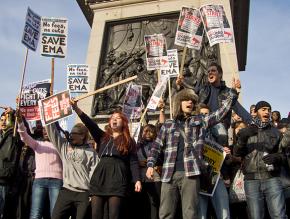The spring of student revolt
reviews Springtime: The New Student Rebellions, a new collection of writing on the global student rebellion.
IN HINDSIGHT, the British student movement of November-December 2010 was a turning point in the global uprising against austerity and injustice.
Coming hot on the heels of the mass rebellion against pension reform in France, the British student protests demonstrated that the international upsurge in struggle had begun to acquire real momentum--rather than emerging in one country and then fading away, protest movements were building on and drawing inspiration from one another.
Just weeks after British students took over the streets of London and clashed with police during demonstrations against rising tuition fees, the global movement took another leap forward with the outbreak of revolutions in Tunisia and then Egypt.
Verso's new book Springtime: The New Student Rebellions places the British protests of last winter in the context of a rising wave of student unrest around the world. Alongside Britain, it examines student movements in Italy, California, France, Greece and Tunisia.
Providing a combination of insightful analysis and engaged activist-journalism, Springtime is an indispensable guide to understanding the past, present and future of the global youth rebellion.

As the editors of Springtime correctly argue, the recent student protests cannot be understood outside the context of the ongoing economic crisis. In the aftermath of the global financial meltdown of 2008, governments around the world spent trillions of dollars to save the banks and then embarked on a vicious program of austerity in order to make poor people, workers and youth pay for the bailouts.
In country after country, the austerity agenda has included attacks on higher education: rising tuition and fees, privatization and major assaults on academic freedom and critical thinking. "Our rulers thought that now was the perfect moment drastically to restructure higher education," write Clare Solomon and Tania Palmieri in the book's introduction.
And yet the attack on universities has run head-on into a wave of student resistance without precedent in a generation. From Los Angeles to London, young people have taken to the streets and taken over buildings as they express their fury at the rising cost and declining quality of their education.
SPRINGTIME BRINGS together the first-hand accounts of dozens of participants in this fightback. The experiences and struggles recounted in this book are too rich and too varied to receive the justice they deserve in a short review. But a couple of key themes do emerge.
The first is the reappearance of the occupation as a militant tactic of protest for students around the world. Springtime brings together the reflections of participants in building occupations from cities and campuses around the world, and a number of threads connect the experiences of these occupiers.
For one thing, campus occupations pose the question: who controls our education? As Jo Casserly, a participant in the occupation of University College London (UCL) in late 2010 notes:
The people running our universities are not elected, and are not accountable to staff or students. And they have failed to defend our education and effectively oppose the cuts. It was time to take our campuses into our own hands.
Likewise, when students at the University of California Berkeley occupied a building a year earlier, they issued a statement saying, "[W]e can open the doors to all who wish to join us, we can come and go freely and let others take our place in determining how the space is used."
Once they were under the control of students, occupied spaces became important hubs for debate, discussion and further organizing--and it is through this process that students become more conscious of, and confident in, their collective ability to change the world. Casserly vividly describes how this phenomenon developed during the occupation of UCL:
The occupations were also centers for creativity...Not only did we organize direct action, demonstrations and flash mobs, but we also created a solid network of activists...The experience of living and organizing together was exhausting but extraordinary, creating bonds of trust, respect and comradeship between students.
The second key them that emerges in Springtime is the extraordinary level of state repression faced by students attempting to resist the attacks on higher education. It was during the mass student protests in London in November and December 2010, for example, that the police tactic of "kettling" first received international notoriety.
Similar levels of police brutality greeted the movement in California. In the words of a document issued by protesters at the University of California Santa Cruz after students were pepper-sprayed and arrested, "The beatings will continue."
Despite the media hysteria about the violence of student rebels, therefore, Springtime contributor Peter Hallward is surely to correct to note "the great majority of violence has been suffered rather than inflicted by the protesters."
But the message of Springtime is not one of fear of the police and their violence--it is a message that a new generation is standing up and fighting back. In the words of Jody McIntyre, a wheelchair-bound activist attacked by police at a student protest in London:
As long as the government continues to pursue its policy of a two-tier education system and an ideology of inequality, we have every right to demonstrate, to resist and to fight for an equal education for all.


